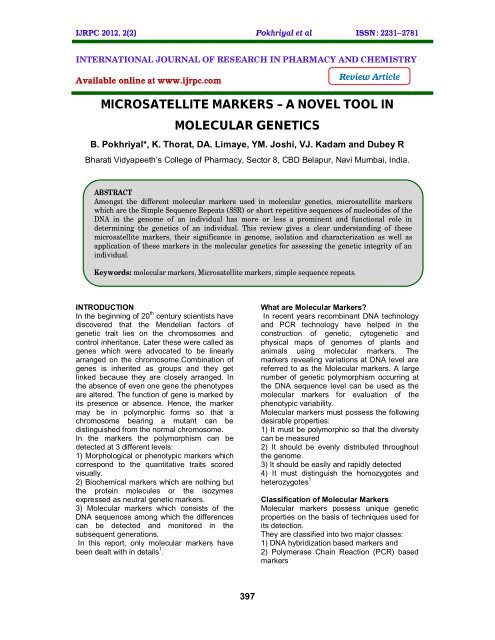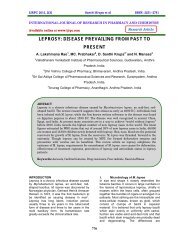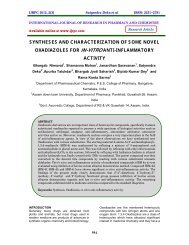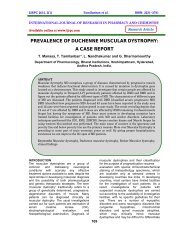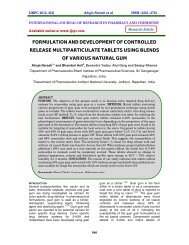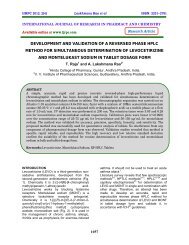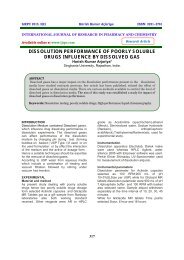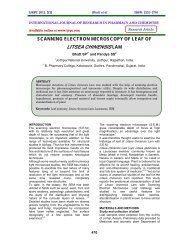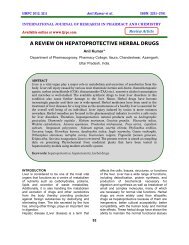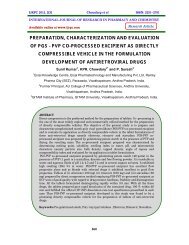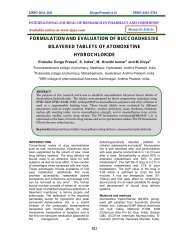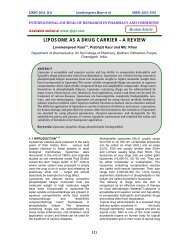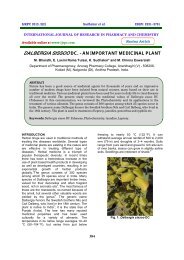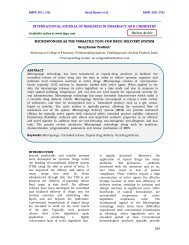microsatellite markers – a novel tool in molecular genetics - ijrpc
microsatellite markers – a novel tool in molecular genetics - ijrpc
microsatellite markers – a novel tool in molecular genetics - ijrpc
Create successful ePaper yourself
Turn your PDF publications into a flip-book with our unique Google optimized e-Paper software.
IJRPC 2012, 2(2) Pokhriyal et al ISSN: 22312781<br />
INTERNATIONAL JOURNAL OF RESEARCH IN PHARMACY AND CHEMISTRY<br />
Available onl<strong>in</strong>e at www.<strong>ijrpc</strong>.com<br />
Review Article<br />
MICROSATELLITE MARKERS <strong>–</strong> A NOVEL TOOL IN<br />
MOLECULAR GENETICS<br />
B. Pokhriyal*, K. Thorat, DA. Limaye, YM. Joshi, VJ. Kadam and Dubey R<br />
Bharati Vidyapeeth’s College of Pharmacy, Sector 8, CBD Belapur, Navi Mumbai, India.<br />
ABSTRACT<br />
Amongst the different <strong>molecular</strong> <strong>markers</strong> used <strong>in</strong> <strong>molecular</strong> <strong>genetics</strong>, <strong>microsatellite</strong> <strong>markers</strong><br />
which are the Simple Sequence Repeats (SSR) or short repetitive sequences of nucleotides of the<br />
DNA <strong>in</strong> the genome of an <strong>in</strong>dividual has more or less a prom<strong>in</strong>ent and functional role <strong>in</strong><br />
determ<strong>in</strong><strong>in</strong>g the <strong>genetics</strong> of an <strong>in</strong>dividual. This review gives a clear understand<strong>in</strong>g of these<br />
<strong>microsatellite</strong> <strong>markers</strong>, their significance <strong>in</strong> genome, isolation and characterization as well as<br />
application of these <strong>markers</strong> <strong>in</strong> the <strong>molecular</strong> <strong>genetics</strong> for assess<strong>in</strong>g the genetic <strong>in</strong>tegrity of an<br />
<strong>in</strong>dividual.<br />
Keywords: <strong>molecular</strong> <strong>markers</strong>, Microsatellite <strong>markers</strong>, simple sequence repeats.<br />
INTRODUCTION<br />
In the beg<strong>in</strong>n<strong>in</strong>g of 20 th century scientists have<br />
discovered that the Mendelian factors of<br />
genetic trait lies on the chromosomes and<br />
control <strong>in</strong>heritance. Later these were called as<br />
genes which were advocated to be l<strong>in</strong>early<br />
arranged on the chromosome.Comb<strong>in</strong>ation of<br />
genes is <strong>in</strong>herited as groups and they get<br />
l<strong>in</strong>ked because they are closely arranged. In<br />
the absence of even one gene the phenotypes<br />
are altered. The function of gene is marked by<br />
its presence or absence. Hence, the marker<br />
may be <strong>in</strong> polymorphic forms so that a<br />
chromosome bear<strong>in</strong>g a mutant can be<br />
dist<strong>in</strong>guished from the normal chromosome.<br />
In the <strong>markers</strong> the polymorphism can be<br />
detected at 3 different levels:<br />
1) Morphological or phenotypic <strong>markers</strong> which<br />
correspond to the quantitative traits scored<br />
visually.<br />
2) Biochemical <strong>markers</strong> which are noth<strong>in</strong>g but<br />
the prote<strong>in</strong> molecules or the isozymes<br />
expressed as neutral genetic <strong>markers</strong>.<br />
3) Molecular <strong>markers</strong> which consists of the<br />
DNA sequences among which the differences<br />
can be detected and monitored <strong>in</strong> the<br />
subsequent generations.<br />
In this report, only <strong>molecular</strong> <strong>markers</strong> have<br />
been dealt with <strong>in</strong> details 1 .<br />
What are Molecular Markers?<br />
In recent years recomb<strong>in</strong>ant DNA technology<br />
and PCR technology have helped <strong>in</strong> the<br />
construction of genetic, cytogenetic and<br />
physical maps of genomes of plants and<br />
animals us<strong>in</strong>g <strong>molecular</strong> <strong>markers</strong>. The<br />
<strong>markers</strong> reveal<strong>in</strong>g variations at DNA level are<br />
referred to as the Molecular <strong>markers</strong>. A large<br />
number of genetic polymorphism occurr<strong>in</strong>g at<br />
the DNA sequence level can be used as the<br />
<strong>molecular</strong> <strong>markers</strong> for evaluation of the<br />
phenotypic variability.<br />
Molecular <strong>markers</strong> must possess the follow<strong>in</strong>g<br />
desirable properties:<br />
1) It must be polymorphic so that the diversity<br />
can be measured<br />
2) It should be evenly distributed throughout<br />
the genome.<br />
3) It should be easily and rapidly detected<br />
4) It must dist<strong>in</strong>guish the homozygotes and<br />
heterozygotes 1<br />
Classification of Molecular Markers<br />
Molecular <strong>markers</strong> possess unique genetic<br />
properties on the basis of techniques used for<br />
its detection.<br />
They are classified <strong>in</strong>to two major classes:<br />
1) DNA hybridization based <strong>markers</strong> and<br />
2) Polymerase Cha<strong>in</strong> Reaction (PCR) based<br />
<strong>markers</strong><br />
397
IJRPC 2012, 2(2) Pokhriyal et al ISSN: 22312781<br />
1) DNA hybridization based <strong>markers</strong><br />
The DNA piece can be cloned, and allowed to<br />
hybridize with the genomic DNA which can be<br />
detected. Marker-based DNA hybridization has<br />
been widely used but the major limitation of<br />
this approach is that it requires large quantities<br />
of DNA and the use of radioactive labeled<br />
probes.<br />
This method basically <strong>in</strong>volves the follow<strong>in</strong>g<br />
steps:<br />
1) Isolation of genomic DNA,<br />
2) Its digestion by the restriction enzymes,<br />
3) Separation by gel electrophoresis and<br />
then<br />
4) Hybridization by <strong>in</strong>cubat<strong>in</strong>g with cloned<br />
and labeled probes.<br />
2) PCR based <strong>markers</strong><br />
Polymerase Cha<strong>in</strong> Reaction (PCR) is a <strong>novel</strong><br />
technique for the amplification of the selected<br />
regions of the DNA. The advantage with PCR<br />
is that even a m<strong>in</strong>ute quantity of DNA can be<br />
amplified to a large extent and hence it<br />
requires only a small quantity of DNA to start<br />
with.<br />
PCR-based <strong>markers</strong> may be divided <strong>in</strong>to two<br />
types:<br />
1) Locus non-specific <strong>markers</strong> :<br />
e.g. a) Random amplified polymorphic DNA<br />
(RAPD);<br />
b) Amplified fragment length polymorphism<br />
(AFLP).<br />
S<strong>in</strong>ce they are locus nonspecific they doesn’t<br />
give the relevant and precise <strong>in</strong>formation<br />
about the genome and the genes and the<br />
pattern of their occurrence and <strong>in</strong>heritance.<br />
Hence, the locus specific <strong>markers</strong> are more<br />
preferred.<br />
2) Locus specific <strong>markers</strong> :<br />
e.g. a) Simple sequence repeats (SSR);<br />
b) S<strong>in</strong>gle nucleotide polymorphism (SNP).<br />
Among the segregat<strong>in</strong>g populations, the<br />
phylogenetic <strong>markers</strong> are very useful for<br />
mapp<strong>in</strong>g the polygenic traits as well as<br />
Mendelian traits. The most widespread among<br />
the polygenic <strong>markers</strong> are the Variable<br />
number of tandem repeats (VNTRs) or<br />
Microsatellites. The locus-specific probe fails<br />
to cover it and shows the highly polyallelic<br />
fragment length variation. For e.g. the tandem<br />
repeat loci associated with rRNA genes which<br />
are concentrated at nucleolar organiz<strong>in</strong>g<br />
regions (NORs) of certa<strong>in</strong> chromosomes of an<br />
<strong>in</strong>dividual. Similarly, most VNTRs loci get<br />
centered <strong>in</strong> pro-term<strong>in</strong>al regions of human<br />
chromosomes. Therefore, the desired density<br />
of <strong>markers</strong> is not provided. This difficulty is<br />
overcome <strong>in</strong> Microsatellite or SSR (Simple<br />
Sequence Repeats) loci 2 .<br />
What are Microsatellites?<br />
The term Microsatellite was first co<strong>in</strong>ed by Lit<br />
and Lutty. These are also known as the<br />
Simple sequence repeat (SSR) or Short<br />
tandem repeat (STR). These are the stretches<br />
of DNA, consist<strong>in</strong>g of tandemly repeat<strong>in</strong>g<br />
mono-, di-, tri-, tetra- and penta- nucleotide<br />
units, which are arranged throughout the<br />
genomes of most eukaryotic species. For<br />
example,<br />
AAAAAAAAAAA would be referred to as (A) 11<br />
GTGTGTGTGTGT would be referred to as<br />
(GT) 6<br />
ACTCACTCACTCACTC would be referred to<br />
as (ACTC) 4<br />
They are often represented as (CA) n repeat,<br />
where n is variable between alleles and CA is<br />
the most commonly found repeated units of<br />
cytos<strong>in</strong>e <strong>–</strong> aden<strong>in</strong>e pair <strong>in</strong> the human genome<br />
.The existence of d<strong>in</strong>ucleotide repeats- poly<br />
(C-A), poly (G-T) (i.e. an alternat<strong>in</strong>g sequence<br />
of cytos<strong>in</strong>e and aden<strong>in</strong>e, with on the opposite<br />
strand of the DNA molecule, alternat<strong>in</strong>g<br />
guan<strong>in</strong>e and thym<strong>in</strong>e) was first documented<br />
almost 15 years ago by Hamada and<br />
colleagues. Subsequent studies by Tautz and<br />
Renz have confirmed both the abundance and<br />
ubiquity of <strong>microsatellite</strong>s <strong>in</strong> eukaryotes which<br />
are <strong>in</strong>herited <strong>in</strong> a Mendelian fashion 3 .<br />
Why Microsatellite Markers are Preferred<br />
over other Molecular Markers? 3<br />
There are several widely used marker types<br />
available for <strong>molecular</strong> ecology studies, and<br />
many questions can be addressed with more<br />
than one type of marker. Microsatellites are of<br />
particular <strong>in</strong>terest to ecologists because they<br />
are one of the few <strong>molecular</strong> <strong>markers</strong> that<br />
allow researchers <strong>in</strong>sight <strong>in</strong>to f<strong>in</strong>e-scale<br />
ecological questions. Regardless of the<br />
question, a <strong>molecular</strong> marker must<br />
fundamentally be selectively neutral and follow<br />
Mendelian <strong>in</strong>heritance <strong>in</strong> order to be used as a<br />
<strong>tool</strong> for detect<strong>in</strong>g demographic patterns, and<br />
these traits should always be confirmed for<br />
any marker type. The desirable traits of<br />
<strong>microsatellite</strong>s compared with other marker<br />
types such as allozymes, amplified fragment<br />
length polymorphisms(AFLP), sequenced loci<br />
and s<strong>in</strong>gle nuclear polymorphisms (SNP),<br />
focused on both practicalities and ecological<br />
considerations are as under<br />
1) Easy sample preparation 3<br />
An ideal marker allows the use of small tissue<br />
samples which are easily preserved for future<br />
use. In contrast to allozyme methods, DNAbased<br />
techniques, such as <strong>microsatellite</strong>s, use<br />
PCR to amplify the marker of <strong>in</strong>terest from a<br />
m<strong>in</strong>ute tissue sample. The stability of DNA<br />
398
IJRPC 2012, 2(2) Pokhriyal et al ISSN: 22312781<br />
compared with enzymes allows the use of<br />
simple tissue preservatives (such as 95%<br />
ethanol) for storage. In addition, because<br />
<strong>microsatellite</strong>s are usually shorter <strong>in</strong> length<br />
than sequenced loci (100<strong>–</strong>300 vs. 500<strong>–</strong>1500<br />
base pairs) they can still be amplified with<br />
PCR despite some DNA degradation (Taberlet<br />
et al. 1999) [5] . As DNA degrades, it breaks <strong>in</strong>to<br />
smaller pieces and the chance of successfully<br />
amplify<strong>in</strong>g a long segment is proportional to its<br />
length (Frantzen et al. 1998) [6] . This trait allows<br />
<strong>microsatellite</strong>s to be used with fast and cheap<br />
DNA extraction methods, with ancient DNA, or<br />
DNA from hair and faecal samples used <strong>in</strong><br />
non-<strong>in</strong>vasive sampl<strong>in</strong>g (Taberlet et al.<br />
1999).Furthermore, because <strong>microsatellite</strong>s<br />
are species-specific, cross-contam<strong>in</strong>ation by<br />
non-target organisms is much less of a<br />
problem compared with techniques that<br />
employ universal primers (i.e. primers that will<br />
amplify DNA from any species), such as<br />
AFLP. This feature is of particular importance<br />
when work<strong>in</strong>g with faecal samples or species,<br />
such as scleract<strong>in</strong>ian corals, <strong>in</strong> which<br />
endosymbiont contam<strong>in</strong>ation is practically<br />
unavoidable.<br />
2) High <strong>in</strong>formation content 3<br />
Each marker locus can be considered a<br />
sample of the genome. Because of<br />
recomb<strong>in</strong>ation, selection and genetic drift,<br />
different genes and different regions of the<br />
genome have slightly different genealogical<br />
histories. Rely<strong>in</strong>g on a s<strong>in</strong>gle locus to estimate<br />
ecological traits from genetic data creates a<br />
high rate of sampl<strong>in</strong>g error. Thus, tak<strong>in</strong>g<br />
multiple samples of the genome by comb<strong>in</strong><strong>in</strong>g<br />
the results from many loci provides a more<br />
precise and statistically powerful way of<br />
compar<strong>in</strong>g populations and <strong>in</strong>dividuals.<br />
Furthermore, statistical approaches to the<br />
questions of most <strong>in</strong>terest to ecologists often<br />
require multiple, comparable loci ( Pearse &<br />
Crandall 2004). Although AFLP, allozymes<br />
and random amplified polymorphic DNA<br />
(RAPD) techniques are also multilocus, none<br />
of them have the resolution and power of a<br />
multilocus <strong>microsatellite</strong> study (but for dist<strong>in</strong>ct<br />
reasons; see Sunnucks 2000). While AFLP<br />
<strong>markers</strong> can be a good alternative choice to<br />
<strong>microsatellite</strong>s (Bensch & Akesson 2005).<br />
Gerber et al. (2000) showed that 159 AFLP<br />
loci provided slightly less power to determ<strong>in</strong>e<br />
paternity than six polymorphic <strong>microsatellite</strong><br />
<strong>markers</strong>. Sequenc<strong>in</strong>g technology has<br />
advanced rapidly, but its cost still prohibits the<br />
duplication or triplication of workload by us<strong>in</strong>g<br />
multiple <strong>in</strong>dependent gene sequences <strong>in</strong><br />
parallel (Zhang & Hewitt 2003). SNP <strong>markers</strong><br />
hold great promise for future studies but their<br />
use <strong>in</strong> non-model organisms is still nascent<br />
(Mor<strong>in</strong> et al. 2004).<br />
3) Co-dom<strong>in</strong>ant <strong>markers</strong> 3<br />
Microsatellites have become so popular<br />
because they are s<strong>in</strong>gle locus, co-dom<strong>in</strong>ant<br />
<strong>markers</strong> for which many loci can be efficiently<br />
comb<strong>in</strong>ed <strong>in</strong> the genotyp<strong>in</strong>g process to provide<br />
fast and <strong>in</strong>expensive replicated sampl<strong>in</strong>g of<br />
the genome. Microsatellite <strong>markers</strong> generally<br />
have high-mutation rates result<strong>in</strong>g <strong>in</strong> high<br />
stand<strong>in</strong>g allelic diversity. In species for which<br />
populations are small or recently bottlenecked,<br />
<strong>markers</strong> with lower mutation rates, such as<br />
allozymes, may be largely <strong>in</strong>variant and only<br />
loci with the highest mutation rates are likely to<br />
be <strong>in</strong>formative (Hedrick 1999). A slow<br />
mutational process allows the signature of<br />
events <strong>in</strong> the distant past to persist longer.<br />
Thus, the selection of loci with high or low<br />
allelic diversity will depend on the question of<br />
<strong>in</strong>terest. For example, if one is <strong>in</strong>terested <strong>in</strong> a<br />
potential historical barrier to gene flow or<br />
trac<strong>in</strong>g the recolonization of territory s<strong>in</strong>ce the<br />
last ice age, <strong>markers</strong> with lower mutational<br />
rates are likely to be the most <strong>in</strong>formative. [3]<br />
Attributes of Microsatellites as Genetic<br />
<strong>markers</strong><br />
Some of the significant attributes of<br />
<strong>microsatellite</strong> <strong>markers</strong> which they possess are<br />
as follows:<br />
1) Locus-specific <strong>in</strong> nature; <strong>in</strong> contrast to<br />
multi-locus <strong>markers</strong> such as m<strong>in</strong>isatellites<br />
or Random amplified<br />
polymorphic DNA (RAPDs)<br />
2) Co-dom<strong>in</strong>ant transmission and therefore<br />
the heterozygotes can be dist<strong>in</strong>guished<br />
from homozygotes, <strong>in</strong> contrast to<br />
Random amplified polymorphic DNA<br />
(RAPD); Amplified fragment length<br />
polymorphism (AFLP) which are b<strong>in</strong>ary <strong>in</strong><br />
nature<br />
3) Highly polymorphic and hyper-variable<br />
4) High <strong>in</strong>formation content and provides<br />
considerable pattern<br />
5) Relative abundance with uniform genome<br />
coverage<br />
6) Higher mutation rate than standard<br />
sequences (up to<br />
0.001gamates/generation)<br />
7) High probability of back mutation 4 .<br />
399
IJRPC 2012, 2(2) Pokhriyal et al ISSN: 22312781<br />
Significance of Microsatellites In Genome 4<br />
As there are often many alleles present at a<br />
<strong>microsatellite</strong> locus, genotypes with<strong>in</strong><br />
pedigrees are often fully <strong>in</strong>formative, <strong>in</strong> that<br />
the progenitor of a particular allele can often<br />
be identified. In this way, <strong>microsatellite</strong>s can<br />
be used for determ<strong>in</strong><strong>in</strong>g paternity, population<br />
genetic studies and recomb<strong>in</strong>ation mapp<strong>in</strong>g. It<br />
is also the only <strong>molecular</strong> marker to provide<br />
clues about which alleles are more closely<br />
related. Also, these <strong>markers</strong> often present high<br />
levels of <strong>in</strong>ter- and <strong>in</strong>tra-specific<br />
polymorphism, particularly when tandem<br />
repeats number are 10 or greater.<br />
The Significance of Microsatellite <strong>markers</strong> are<br />
as under:<br />
Microsatellites determ<strong>in</strong>e the genotype<br />
of an <strong>in</strong>dividual. They usually don't have any<br />
measurable effect on phenotype, and when<br />
they do mutate, may cause a change <strong>in</strong> the<br />
genotype of an <strong>in</strong>dividual.<br />
Microsatellites may act as a marker for<br />
some genetic diseases. They were previously<br />
considered to be as the "Junk" DNA which is<br />
generally found on the Non-cod<strong>in</strong>g regions of<br />
DNA and the variation is mostly neutral.In<br />
humans, 90% of known <strong>microsatellite</strong>s are<br />
found <strong>in</strong> non-cod<strong>in</strong>g regions of the<br />
genome. When found <strong>in</strong> human cod<strong>in</strong>g<br />
regions, <strong>microsatellite</strong>s are known to cause<br />
disease. Interest<strong>in</strong>gly, when found <strong>in</strong> cod<strong>in</strong>g<br />
regions, <strong>microsatellite</strong>s are usually tr<strong>in</strong>ucleotide<br />
repeats. One possible explanation<br />
is that any other type of nucleotide repeat<br />
would be too detrimental to the cod<strong>in</strong>g region,<br />
because it would cause a frame-shift mutation.<br />
Microsatellites provide a necessary<br />
source of genetic variation. The variation <strong>in</strong><br />
<strong>microsatellite</strong> alleles <strong>in</strong> cod<strong>in</strong>g regions is<br />
thought to be the cause of adaptation <strong>in</strong><br />
different environments. In other words, a short<br />
allele may be adaptive <strong>in</strong> one environment,<br />
and a long allele with many repeats may be<br />
adaptive <strong>in</strong> a different environment.<br />
Microsatellite variation may be a way<br />
to compensate for loss of genetic variability<br />
due to genetic drift and selection. Thus hav<strong>in</strong>g<br />
variation with<strong>in</strong> the population would ensure<br />
the survival of the population <strong>in</strong> vary<strong>in</strong>g<br />
environment.<br />
Microsatellites may help regulate gene<br />
expression and prote<strong>in</strong> function.Kashi and<br />
Soller (1999) have suggested that<br />
<strong>microsatellite</strong>s may have regulatory roles <strong>in</strong><br />
gene expression. They are systematically<br />
found near cod<strong>in</strong>g regions. Variation <strong>in</strong><br />
<strong>microsatellite</strong> alleles have been shown to be<br />
associated with quantitative variation <strong>in</strong> prote<strong>in</strong><br />
function and gene activity.<br />
Mutation <strong>in</strong> Microsatellites 5<br />
Microsatellites owe their variability to an<br />
<strong>in</strong>creased rate of mutation compared to other<br />
neutral regions of DNA. The size of the repeat<br />
unit, the number of repeats and the presence<br />
of variant repeats are all factors, as well as the<br />
frequency of transcription <strong>in</strong> the area of the<br />
DNA repeat. Interruption of <strong>microsatellite</strong>s,<br />
perhaps due to mutation, can result <strong>in</strong> reduced<br />
polymorphism. The reason seems to be that<br />
their mutations occur <strong>in</strong> a fashion very different<br />
from that of "classical" po<strong>in</strong>t mutations (where<br />
a substitution of one nucleotide to another<br />
occurs, such as a G substitut<strong>in</strong>g for a C).<br />
The mutation process <strong>in</strong> <strong>microsatellite</strong>s<br />
occurs through what is known as slippage<br />
replication. If we consider the repeat units<br />
(e.g., an AC d<strong>in</strong>ucleotide repeat) as beads on<br />
a cha<strong>in</strong>, we can imag<strong>in</strong>e that dur<strong>in</strong>g replication<br />
two strands could slip relative positions a bit,<br />
but still manage to get the zipper go<strong>in</strong>g down<br />
the beads. One strand or the other could then<br />
be lengthened or shortened by addition or<br />
excision of nucleotides. The result will be a<br />
<strong>novel</strong> "mutation" that comprises a repeat unit<br />
that is one bead longer or shorter than the<br />
orig<strong>in</strong>al.<br />
It is estimated that <strong>microsatellite</strong>s mutate 100<br />
to 10,000 times as fast as base pair<br />
substitutions. This makes <strong>microsatellite</strong>s<br />
useful for study<strong>in</strong>g evolution over short time<br />
spans, whereas base pair substitutions are<br />
more useful for study<strong>in</strong>g evolution over long<br />
time spans (millions of years). Microsatellite<br />
alleles mutate over time. In a population, there<br />
may exist many alleles of a s<strong>in</strong>gle<br />
<strong>microsatellite</strong> locus. Microsatellite alleles differ<br />
<strong>in</strong> the number of repeats. For example, one<br />
allele may have 7 repeats of a CT motif, and<br />
another allele may have 8 repeats. In a<br />
population, there may exist many alleles at a<br />
s<strong>in</strong>gle locus, with each allele hav<strong>in</strong>g a different<br />
length. An <strong>in</strong>dividual who is homozygous for a<br />
locus will have the same number of repeats on<br />
both chromosomes, whereas a heterozygous<br />
<strong>in</strong>dividual will have different numbers of<br />
repeats on the two chromosomes.<br />
The regions surround<strong>in</strong>g the <strong>microsatellite</strong><br />
locus, called the flank<strong>in</strong>g regions, may still<br />
have the same sequence. This is important<br />
because the flank<strong>in</strong>g regions can therefore be<br />
used as PCR primers when amplify<strong>in</strong>g<br />
<strong>microsatellite</strong> loci, and can be conserved<br />
across genera or sometimes even<br />
families. Below, the two l<strong>in</strong>es represent the<br />
sequences on two homologous chromosomes<br />
<strong>in</strong> a diploid organism.<br />
400
IJRPC 2012, 2(2) Pokhriyal et al ISSN: 22312781<br />
Homozygous<br />
(Both strands have 7 CT repeats)<br />
…CGTAGCCTTGCATCCTTCTCTCTCTCTCT<br />
CTATCGGTACTACGTGG…<br />
…CGTAGCCTTGCATCCTTCTCTCTCTCTCT<br />
CTATCGGTACTACGTGG…<br />
5’ flank<strong>in</strong>g region <strong>microsatellite</strong> locus 3’ flank<strong>in</strong>g region<br />
Heterozygous<br />
(One strand has 7 repeats, and the other has<br />
8 repeats)<br />
…CGTAGCCTTGCATCCTTCTCTCTCTCTCT<br />
CTATCGGTACTACGTGG…<br />
…CGTAGCCTTGCATCCTTCTCTCTCTCTCT<br />
CTCTATCGGTACTACGTGG…<br />
Microsatellites are useful genetic <strong>markers</strong><br />
because they tend to be highly polymorphic. It<br />
is not uncommon to have human<br />
<strong>microsatellite</strong>s with 20 or more alleles with<br />
heterozygosities. [8]<br />
Microsatellites generally tend to occur <strong>in</strong> noncod<strong>in</strong>g<br />
regions of the DNA although a few<br />
human genetic disorders are caused by (tr<strong>in</strong>ucleotide)<br />
<strong>microsatellite</strong> regions <strong>in</strong> cod<strong>in</strong>g<br />
regions. On each side of the repeat unit<br />
are flank<strong>in</strong>g regions that consist of "unordered"<br />
DNA. The flank<strong>in</strong>g regions are critical because<br />
they allow us to develop locus-specific primers<br />
to amplify the <strong>microsatellite</strong>s with PCR<br />
(polymerase cha<strong>in</strong> reaction). That is, given a<br />
stretch of unordered DNA 30-50 base pairs<br />
(bp) long, the probability of f<strong>in</strong>d<strong>in</strong>g that<br />
particular stretch more than once <strong>in</strong> the<br />
genome becomes vanish<strong>in</strong>gly small. This<br />
comb<strong>in</strong>ation of widely occurr<strong>in</strong>g repeat units<br />
and locus-specific flank<strong>in</strong>g regions are a part<br />
of strategy for f<strong>in</strong>d<strong>in</strong>g and develop<strong>in</strong>g<br />
<strong>microsatellite</strong> primers. The primers for PCR<br />
will be sequences from these unique flank<strong>in</strong>g<br />
regions. By hav<strong>in</strong>g a forward and a reverse<br />
primer on each side of the <strong>microsatellite</strong>, we<br />
will be able to amplify a fairly short (100 to 500<br />
bp, where bp means base pairs) locus-specific<br />
<strong>microsatellite</strong> region.<br />
There are two hypotheses that expla<strong>in</strong> how<br />
<strong>microsatellite</strong>s mutate 5<br />
1. “Polymerase slippage” or “slippedstrand<br />
mispair<strong>in</strong>g”: When the DNA<br />
replicates, the polymerase loses track of its<br />
place, and either leaves out repeat units or<br />
adds too many repeat units. The result is that<br />
the new strand has a different number of<br />
repeats as the parent strand. This is thought to<br />
expla<strong>in</strong> small changes <strong>in</strong> numbers of repeats.<br />
It also expla<strong>in</strong>s how <strong>microsatellite</strong> loci could be<br />
generated <strong>in</strong> the first place; it is likely that<br />
sequences <strong>in</strong>clud<strong>in</strong>g two or three repeats are<br />
randomly distributed throughout the<br />
genome. Slippage could then amplify these<br />
401<br />
short repeat sequences <strong>in</strong>to many repeats<br />
over successive generations. Certa<strong>in</strong>ly, the<br />
effectiveness of the mismatch repair system<br />
would also play an important role <strong>in</strong><br />
<strong>microsatellite</strong> mutation rate.<br />
2. Unequal cross<strong>in</strong>g-over dur<strong>in</strong>g<br />
meiosis:This is thought to expla<strong>in</strong> more<br />
drastic changes <strong>in</strong> numbers of repeats. In the<br />
diagram below, chromosome A obta<strong>in</strong>ed too<br />
many repeats dur<strong>in</strong>g cross<strong>in</strong>g-over and<br />
chromosome B obta<strong>in</strong>ed too few repeats. 9<br />
Model for Microsatellite Mutation 5<br />
Many models have been proposed to expla<strong>in</strong><br />
the mutation <strong>in</strong> <strong>microsatellite</strong>s but due to some<br />
or the other limitations or unexpla<strong>in</strong>ed facts<br />
they have been discarded. So a model is<br />
proposed which expla<strong>in</strong>s most of the<br />
mutational mechanisms and facts and<br />
uncerta<strong>in</strong>ties <strong>in</strong> <strong>microsatellite</strong> mutation are<br />
been described <strong>in</strong> stepwise mutation model as<br />
follows:<br />
Stepwise Mutation Model (SMM)<br />
The idea that add<strong>in</strong>g or subtract<strong>in</strong>g one repeat<br />
is likely easier than add<strong>in</strong>g or subtract<strong>in</strong>g two<br />
or more beads is the basis for us<strong>in</strong>g<br />
the Stepwise Mutation Model (SMM). This<br />
model holds that when <strong>microsatellite</strong>s mutate,<br />
they only ga<strong>in</strong> or lose one repeat. This implies<br />
that two alleles that differ by one repeat are<br />
more closely related (have a more recent<br />
common ancestor) than alleles that differ by<br />
many repeats. In other words, size matters<br />
when do<strong>in</strong>g statistical tests of population substructur<strong>in</strong>g.<br />
An advantage of the SMM is that<br />
the difference <strong>in</strong> size conveys additional<br />
<strong>in</strong>formation about the phylogeny of alleles. The<br />
SMM is generally the preferred model when<br />
calculat<strong>in</strong>g relatedness between <strong>in</strong>dividuals<br />
and population sub-structur<strong>in</strong>g, although there<br />
is the problem of homoplasy.<br />
Problem: Homoplasy<br />
Pretend that you are study<strong>in</strong>g a population and<br />
you f<strong>in</strong>d four <strong>in</strong>dividuals. Three of them have<br />
the same genotype, and one is different. This<br />
would <strong>in</strong>dicate that the three with the same<br />
genotype are more closely related to each<br />
other than they are to the other. However, this<br />
is not necessarily the case. To understand<br />
why, study the phylogeny below. Asterisks<br />
<strong>in</strong>dicate <strong>microsatellite</strong> mutations.
IJRPC 2012, 2(2) Pokhriyal et al ISSN: 22312781<br />
In the fig; population 1 gave rise to two<br />
populations, 2 and 3.<br />
In population 3, there was a stepwise<br />
mutation, so that now there are four CAG<br />
repeats <strong>in</strong>stead of three.<br />
Population 3 gave rise to two more<br />
populations, 6 and 7.<br />
Population 6 lost a repeat, so now it has three<br />
CAG repeats.<br />
The problem is that populations 4, 5,<br />
and 6 have the same allele at this<br />
<strong>microsatellite</strong> locus, yet they have different<br />
evolutionary histories.We can say that their<br />
alleles are identical <strong>in</strong> state but not by descent.<br />
If a scientist were only exam<strong>in</strong><strong>in</strong>g this one<br />
locus, he/she would mistakenly conclude that<br />
population 6 is more closely related to<br />
populations 4 and 5 than it is to 7.<br />
This phenomenon, when two alleles are<br />
identical <strong>in</strong> state but not identical by descent,<br />
is known as homoplasy.<br />
In population studies, homoplasy can lead to<br />
underestimates of divergence. The only way to<br />
detect homoplasy would be to exam<strong>in</strong>e many<br />
other loci.<br />
Still, homoplasy is thought to have little effect<br />
on populations over a short period of time<br />
(hundreds of generations), and stepwise<br />
mutation model is still the preferred model. [9]<br />
Isolation, Development and<br />
Characterization of Microsatellites 6<br />
Develop<strong>in</strong>g new <strong>microsatellite</strong> <strong>markers</strong> based<br />
on the enrichment technique and primer<br />
optimization steps.<br />
A. Extract DNA from a s<strong>in</strong>gle tissue sample.<br />
B. Create a DNA library:<br />
1. Cut the genome <strong>in</strong>to 500 bp fragments<br />
pieces with a restriction enzyme digest.<br />
2. Attach ‘l<strong>in</strong>ker’ DNA to the ends of each<br />
fragment <strong>–</strong> l<strong>in</strong>ker DNA has a known sequence<br />
so that<br />
primers can be designed to b<strong>in</strong>d to them.<br />
3. Amplify the DNA fragments us<strong>in</strong>g primers<br />
for the l<strong>in</strong>ker ends with PCR.<br />
C. Separate out fragments with repeat<br />
sequences:<br />
1. Mix the DNA fragments with a <strong>microsatellite</strong><br />
probe (an oligonucleotide made of a<br />
repeatsequence of your choice) that can be<br />
recovered magnetically.<br />
2. Promote the hybridization of probes to any<br />
complementary repeat sequences <strong>in</strong> the DNA<br />
Fragments by heat<strong>in</strong>g to denature the DNA<br />
and cool<strong>in</strong>g slowly.<br />
3. Hold a magnet to the tube to attract the<br />
probes (now bound to the DNA), and wash<br />
away therest of the unbound DNA with a<br />
series of r<strong>in</strong>ses.<br />
D. Sequence the fragments to f<strong>in</strong>d<br />
<strong>microsatellite</strong> loci:<br />
1. Us<strong>in</strong>g primers for the l<strong>in</strong>ker DNA, amplify<br />
DNA with PCR to concentrate it.<br />
2. Clone the DNA to prepare it for sequenc<strong>in</strong>g<br />
- <strong>in</strong>sert it <strong>in</strong>to a plasmid, <strong>in</strong>oculate bacteria with<br />
the plasmid, grow the bacteria to replicate the<br />
DNA.<br />
3. Isolate the DNA from the bacteria.<br />
4. Sequence <strong>microsatellite</strong> DNA <strong>in</strong> the plasmid<br />
with primers targeted to the <strong>in</strong>sertion po<strong>in</strong>ts on<br />
the plasmid.<br />
E. Exam<strong>in</strong>e the sequences to f<strong>in</strong>d<br />
<strong>microsatellite</strong> repeats.<br />
F. Design primers for the flank<strong>in</strong>g region of the<br />
<strong>microsatellite</strong>s (with help from a primer<br />
selection software program such as Primer3<br />
which selects optimal primer sites) and have<br />
them made.<br />
G. Attempt amplification of loci with the new<br />
primers. Use a gradient of PCR conditions <strong>in</strong><br />
which the temperatures, times, magnesium<br />
and primer concentrations vary to f<strong>in</strong>d optimal<br />
conditions.<br />
H. Use gel electrophoresis to confirm the<br />
presence of PCR products. Discard primer<br />
pairs that fail to amplify after several attempts.<br />
I. Check for polymorphism by runn<strong>in</strong>g the<br />
successful primer pairs on 10-20 <strong>in</strong>dividuals.<br />
Estimate allelic diversity and heterozygosity<br />
levels. Discard <strong>in</strong>variant loci.<br />
J. Check for reliability. Rerun the successful<br />
primer pairs on the same <strong>in</strong>dividuals twice<br />
more to ensure that genotype scor<strong>in</strong>g is<br />
consistently reproducible. Discard loci with<br />
unreliable amplification.<br />
H. Order fluorescently labeled primers for the<br />
rema<strong>in</strong><strong>in</strong>g loci. Complete the full screen<strong>in</strong>g<br />
process. Discard problematic loci.<br />
K. Streaml<strong>in</strong>e the genotyp<strong>in</strong>g of the full dataset<br />
with the rema<strong>in</strong><strong>in</strong>g loci by establish<strong>in</strong>g a<br />
“multiplex” PCR protocol <strong>–</strong> primers for multiple<br />
loci (labeled with different dyes) are amplified<br />
<strong>in</strong> a s<strong>in</strong>gle PCR reaction 3 .<br />
402
IJRPC 2012, 2(2) Pokhriyal et al ISSN: 22312781<br />
403
IJRPC 2012, 2(2) Pokhriyal et al ISSN: 22312781<br />
404
IJRPC 2012, 2(2) Pokhriyal et al ISSN: 22312781<br />
6<br />
Microsatellite Genotyp<strong>in</strong>g with a DNA<br />
Sequencer<br />
A DNA sequencer is a highly precise gel<br />
electrophoresis apparatus. PCR products are<br />
loaded onto the gel and separated by size by<br />
apply<strong>in</strong>g a charge. A laser scans the gel to<br />
detect bands conta<strong>in</strong><strong>in</strong>g fluorescent dye. The<br />
primers used <strong>in</strong> the PCR reaction are tagged<br />
with different fluorescent dyes to enable this<br />
detection. The sequencer software converts<br />
the band<strong>in</strong>g pattern <strong>in</strong>to a plot with peaks<br />
correspond<strong>in</strong>g to the width and <strong>in</strong>tensity<br />
(height) of each band. The position of the peak<br />
along the x-axis corresponds to the size of the<br />
DNA product <strong>in</strong> the band measured <strong>in</strong> base<br />
pairs (BP). The height/<strong>in</strong>tensity corresponds to<br />
the concentration of the DNA product, which is<br />
a consequence of the efficiency of the<br />
amplification process <strong>in</strong> PCR. One color is<br />
used for a size standard to calibrate the band<br />
positions with the size of the DNA product. An<br />
asterisk identifies all true <strong>microsatellite</strong> alleles<br />
<strong>in</strong> the figures below.<br />
405
IJRPC 2012, 2(2) Pokhriyal et al ISSN: 22312781<br />
A<br />
B<br />
C<br />
D<br />
A) An ideal output<br />
The two alleles of this heterozygote are even<br />
<strong>in</strong> height and easy to dist<strong>in</strong>guish from the<br />
“stutter peaks” adjacent to them <strong>–</strong> dur<strong>in</strong>g PCR<br />
some products are 1, 2 or 3 repeats short due<br />
to errors <strong>in</strong> replication (similar to step-wise<br />
mutation) and show up as evenly spaced<br />
peaks with decreas<strong>in</strong>g height to the left of the<br />
true peak. Some loci show extensive stutter<strong>in</strong>g<br />
and others show virtually none. The stutter<br />
bands are useful for dist<strong>in</strong>guish<strong>in</strong>g<br />
<strong>microsatellite</strong> products from non-specific or<br />
non-target products. Notice that there are<br />
“pull-up peaks” <strong>in</strong> the green section of the<br />
spectrum. Pull-up is due primarily to spectral<br />
overlap <strong>in</strong> the emission spectra of the dyes<br />
which the sequencer records as a false peak<br />
<strong>in</strong> a different color. This is a common artifact of<br />
the DNA sequencer’s analysis process that<br />
can create confusion <strong>in</strong> some situations.<br />
B) Two examples of trickier outputs<br />
The blue genotype is a heterozygote but the 2<br />
alleles are only 1repeat different <strong>in</strong> size. This<br />
creates a characteristic pattern for loci with<br />
stutter <strong>in</strong> which the second peak is higher than<br />
the first because of the additive <strong>in</strong>tensity of the<br />
larger allele’s first stutter peak and the smaller<br />
allele’s true peak. If the first two peaks were<br />
equal <strong>in</strong> height it would be difficult to<br />
determ<strong>in</strong>e if the genotype has one or two<br />
alleles. One clue is that there are 4 stutter<br />
peaks to the right of the largest peak <strong>in</strong>stead<br />
of 3. The second locus <strong>in</strong> this plot is shown<br />
with black dye and has larger alleles. This<br />
locus has no stutter perhaps because there<br />
are few repeats so that the Taq polymerase<br />
doesn’t make stepwise errors. This genotype<br />
is also a heterozygote, but the larger allele is<br />
fa<strong>in</strong>t. Larger alleles usually show at least<br />
slightly shorter peaks because PCR is less<br />
efficient for longer products. Here, the larger<br />
allele is so small that it could be easily<br />
overlooked or mistaken for noise. If any less<br />
PCR product were loaded onto the gel it might<br />
not show up at all <strong>–</strong> <strong>in</strong> which case it would be<br />
an example of “large allele drop-out,” another<br />
common source of <strong>in</strong>flated homozygosity<br />
counts.<br />
C) More examples<br />
When multiple loci are loaded <strong>in</strong> the same gel<br />
lane for efficiency, or amplified together <strong>in</strong> one<br />
PCR “multiplex” reaction, allele peaks can<br />
overlap and be sometimes easy to miss. Here<br />
the green and blue loci share an allele size.<br />
Dist<strong>in</strong>guish<strong>in</strong>g the true alleles is made even<br />
more difficult due to the occurrence of green<br />
pull-up peaks. If the green allele product were<br />
less <strong>in</strong>tense than the blue allele product<br />
(<strong>in</strong>stead of equal as shown here), it might be<br />
mistaken for a pull up peak. Re-runn<strong>in</strong>g the<br />
green locus separately <strong>in</strong> such cases will<br />
m<strong>in</strong>imize scor<strong>in</strong>g error. Here aga<strong>in</strong>, the blue<br />
locus shows two alleles that differ by one base<br />
pair. The heights are the same because this<br />
locus does not show strong stutter. But the<br />
blue locus does show small flank<strong>in</strong>g peaks <strong>–</strong><br />
the left side is a very fa<strong>in</strong>t stutter so only the<br />
largest stutter peak is visible, and the right<br />
406
IJRPC 2012, 2(2) Pokhriyal et al ISSN: 22312781<br />
side might be an “A-Tail,” when the Taq adds<br />
an extra aden<strong>in</strong>e nucleotide onto some copies<br />
of the product, <strong>in</strong>creas<strong>in</strong>g it by 1 bp. It will not<br />
be mistaken for a <strong>microsatellite</strong> allele because<br />
an extreme height difference would not occur<br />
for 2 alleles so close <strong>in</strong> size, as their<br />
amplification efficiencies should be similar.<br />
The black locus is a homozygote. Even though<br />
there is a small black peak on the left side of<br />
the plot, a smaller allele is almost never<br />
shorter than a larger allele. An additional clue<br />
is that the larger black peak is quite fat and tall<br />
-- PCR produces approximately double the<br />
amount of product when an allele is<br />
homozygous because it does not compete for<br />
the Taq with a second allele. The purple locus<br />
represents a “split peak” problem that occurs<br />
from high rates of ATail<strong>in</strong>g by the Taq. The<br />
“+A” peaks occur for all of the stutter peaks,<br />
mak<strong>in</strong>g the scor<strong>in</strong>g difficult, especially for<br />
heterozygotes with closely sized alleles.<br />
Although the true allele is denoted here, a<br />
locus with alleles that look like the purple one<br />
would be too difficult to score reliably. Usually<br />
the problem can be corrected by add<strong>in</strong>g an<br />
extra extension step to the PCR program that<br />
gives the Taq time to add an A-Tail to all<br />
copies of the product consistently.<br />
D) Unscorable loci<br />
The blue locus is a “stegosaur” with<br />
unacceptably high stutter. The black locus has<br />
too many non-specific artifact peaks to reliably<br />
choose the <strong>microsatellite</strong> alleles. The green<br />
locus has been overloaded on the gel or has<br />
unusually high PCR product concentration and<br />
is smear<strong>in</strong>g <strong>in</strong> the lane 3 .<br />
Limitations To Utility of Microsatellites 7<br />
Microsatellites have proved to be versatile<br />
<strong>molecular</strong> <strong>markers</strong>, particularly for population<br />
analysis, but they are not without limitations.<br />
Despite many advantages, <strong>microsatellite</strong><br />
<strong>markers</strong> also have several challenges and<br />
pitfalls that at best complicate the data<br />
analysis, and at worst greatly limit their utility<br />
and confound their analysis. However, all<br />
marker types have some downsides, and the<br />
versatility of <strong>microsatellite</strong>s to address many<br />
types of ecological questions outweighs their<br />
drawbacks for many applications. Fortunately,<br />
many of the pitfalls common to <strong>microsatellite</strong><br />
<strong>markers</strong> can be avoided by careful selection of<br />
loci dur<strong>in</strong>g the isolation process. Speciesspecific<br />
marker isolation PCR-based marker<br />
analysis requires primer sequences that target<br />
the marker regions for amplification. In order to<br />
use the same primer sequence to amplify the<br />
same target from many <strong>in</strong>dividuals, the region<br />
where the primer b<strong>in</strong>ds must be identical, with<br />
few or no mutations caus<strong>in</strong>g <strong>in</strong>ter-<strong>in</strong>dividual<br />
differences. For the gene regions commonly<br />
used as sequenced <strong>markers</strong>, primer regions<br />
are highly conserved, such that they are<br />
<strong>in</strong>variant with<strong>in</strong> species and sometimes even<br />
across broad taxonomic groups. This<br />
sequence conservation necessitates only<br />
m<strong>in</strong>or work to optimize a primer set for a new<br />
species. In contrast, a given pair of<br />
<strong>microsatellite</strong> primers rarely works across<br />
broad taxonomic groups, and so primers are<br />
usually developed a new for each species<br />
(Glenn & Schable 2005). However, the<br />
process of isolat<strong>in</strong>g new <strong>microsatellite</strong> <strong>markers</strong><br />
has become faster and less expensive, which<br />
substantially reduces the failure rate and cost<br />
of new marker isolation <strong>in</strong> many cases (Glenn<br />
& Schable 2005).<br />
Some of the Major limitations <strong>in</strong> utility of<br />
<strong>microsatellite</strong>s are as follows<br />
1. Unclear mutational mechanisms 7<br />
One of the challenges currently be<strong>in</strong>g<br />
addressed by geneticists is that the mutational<br />
processes of <strong>microsatellite</strong>s can be complex<br />
(Schlo¨tterer 2000; Beck et al. 2003; Ellegren<br />
2004). For the majority of ecological<br />
applications, it is not important to know the<br />
exact mutational mechanism of each locus, as<br />
most relevant analyses are <strong>in</strong>sensitive to<br />
mutational mechanism (Neigel 1997).<br />
However, several statistics based on<br />
estimates of allele frequencies (e.g. FST and<br />
RST) rely 618 K. A. Selkoe and R. J. Toonen<br />
2006 Blackwell Publish<strong>in</strong>g Ltd/CNRS explicitly<br />
on a mutation model. Traditionally, the <strong>in</strong>f<strong>in</strong>ite<br />
allele model (IAM), <strong>in</strong> which every mutation<br />
event creates a new allele (whose size is<br />
<strong>in</strong>dependent from the progenitor allele) has<br />
been the model of choice for population<br />
<strong>genetics</strong> analyses, and because it is the<br />
simplest and most general model, cont<strong>in</strong>ues to<br />
be widely used as a default. A model specific<br />
to <strong>microsatellite</strong>s, the stepwise mutational<br />
model (SMM), adds or subtracts one or more<br />
repeat units from the str<strong>in</strong>g of repeats at some<br />
constant rate to mimic the process of errors<br />
dur<strong>in</strong>g DNA replication that generates<br />
mutations, creat<strong>in</strong>g a Gaussian-shaped allele<br />
frequency distribution (Ellegren 2004).<br />
However, nonstepwise mutation processes are<br />
also known to occur, <strong>in</strong>clud<strong>in</strong>g po<strong>in</strong>t mutation<br />
and recomb<strong>in</strong>ation events such as unequal<br />
cross<strong>in</strong>g over and gene conversion (Richard &<br />
Paques 2000). While debate cont<strong>in</strong>ues about<br />
the prevalence of non-stepwise mutation for<br />
<strong>microsatellite</strong>s, the current consensus is that<br />
the frequency and effects are usually low, and<br />
407
IJRPC 2012, 2(2) Pokhriyal et al ISSN: 22312781<br />
stepwise mutation appears to be the dom<strong>in</strong>ant<br />
force creat<strong>in</strong>g new alleles <strong>in</strong> the few model<br />
organisms studied to date (Eisen 1999;<br />
Ellegren 2004). Nevertheless, metrics<br />
employ<strong>in</strong>g the SMM tend to be highly sensitive<br />
to violations of this mutational model (e.g. loci<br />
with non-stepwise mutation or constra<strong>in</strong>ts on<br />
allele size) and thus metrics us<strong>in</strong>g the IAM are<br />
usually more robust and reliable (Ruzzante<br />
1998; Balloux & Lugon-Moul<strong>in</strong> 2002; Landry et<br />
al. 2002). More complex and realistic<br />
mutational models that add the probability of<br />
non-stepwise mutation to the SMM are<br />
beg<strong>in</strong>n<strong>in</strong>g to replace the SMM <strong>in</strong> common<br />
genetic analyses, and are already available <strong>in</strong><br />
several statistical packages (e.g. Piry et al.<br />
1999; Van Oosterhout et al. 2004).<br />
2 Hidden allelic diversity 7<br />
Size-based identification of alleles (i.e. gel<br />
electrophoresis)greatly reduces the time and<br />
expense of <strong>microsatellite</strong> genotyp<strong>in</strong>g<br />
compared with sequenc<strong>in</strong>g each allele <strong>in</strong> each<br />
<strong>in</strong>dividual. However, this shortcut requires the<br />
assumption that all dist<strong>in</strong>ct alleles differ <strong>in</strong><br />
length. In fact, alleles of the same size but<br />
different l<strong>in</strong>eages can be quite common, a<br />
phenomenon termed homoplasy.<br />
Homoplasy dampens the visible allelic<br />
diversity of populations and may <strong>in</strong>flate<br />
estimates of gene flow when mutation rate is<br />
high (Garza & Freimer 1996; Rousset 1996;<br />
Viard et al. 1998; Blankenship et al. 2002;<br />
Epperson 2005).There are two dist<strong>in</strong>ct types of<br />
homoplasy, detectable and undetectable.<br />
Detectable homoplasy can be revealed by<br />
sequenc<strong>in</strong>g alleles. For <strong>in</strong>stance, po<strong>in</strong>t<br />
mutations will leave the size of an allele<br />
unchanged, and <strong>in</strong>sertions or deletions <strong>in</strong> the<br />
flank<strong>in</strong>g region might create a new allele with<br />
the same size as an exist<strong>in</strong>g allele. Detectable<br />
homoplasy appears to affect only a fraction of<br />
genotypes at a fraction of loci, and this bias<br />
appears to be marg<strong>in</strong>al <strong>in</strong> the majority of cases<br />
(Viard et al. 1998; Adams et al. 2004; Curtu et<br />
al. 2004). Adams et al. (2004) found<br />
homoplasy was only common for compound<br />
and/or <strong>in</strong>terrupted repeats. Empirical estimates<br />
of detectable homoplasy reported only a slight<br />
(1<strong>–</strong>2%) underestimation of genetic<br />
differentiation (Adams et al. 2004; Curtu et al.<br />
2004).Undetectable homoplasy occurs when<br />
two alleles are identical <strong>in</strong> sequence but not<br />
identical by descent (i.e. they have different<br />
genealogical histories). Such non-identity<br />
occurs from the random-walk behaviour of the<br />
stepwise mutation process when there is a<br />
back-mutationto a previously exist<strong>in</strong>g size (e.g.<br />
an allele mutates from 5 to 6 repeats and then<br />
a copy of this allele mutates from 6 to 5<br />
repeats) or when two unrelated alleles<br />
converge <strong>in</strong> sequence by chang<strong>in</strong>g repeat<br />
number <strong>in</strong> two different places <strong>in</strong> the<br />
sequence. As the SMM predicts a 50% chance<br />
of backmutation, undetectable homoplasy may<br />
be extensive when mutation rate is high, but<br />
can be accounted for <strong>in</strong> analyses (Slatk<strong>in</strong><br />
1995; Estoup & Cornuet 1999). In general,<br />
homoplasy is often a m<strong>in</strong>imal source of bias<br />
for population genetic studies limited to<br />
populations with a shallow_ history or<br />
moderate effective population size, as the<br />
chance of homoplasy is proportional to the<br />
genetic distance of two <strong>in</strong>dividuals or<br />
populations (Estoup et al. 2002). However,<br />
when used for highly divergent groups, such<br />
as for phylogenetic reconstruction, highmutation<br />
rate loci may be problematic (Estoup<br />
et al. 1995). It is important to note that<br />
undetected homoplasy plagues all marker<br />
types. When appropriate, there are several<br />
methods that can be employed to assess<br />
detectable homoplasy.<br />
3. Problems with amplification 7<br />
F<strong>in</strong>d<strong>in</strong>g a useful DNA marker locus requires<br />
identify<strong>in</strong>g a region of the genome with a<br />
sufficiently high mutation rate that multiple<br />
versions (alleles) exist <strong>in</strong> a given population,<br />
and which is also located adjacent to a low<br />
mutation rate stretch of DNA that will b<strong>in</strong>d<br />
PCR primers <strong>in</strong> the vast majority (approach<strong>in</strong>g<br />
100%) of <strong>in</strong>dividuals of the species. If<br />
mutations occur <strong>in</strong> the primer region, some<br />
<strong>in</strong>dividuals will have only one allele amplified,<br />
or will fail to amplify at all (Paetkau & Strobeck<br />
1995). In addition, primers must b<strong>in</strong>d under<br />
repeatable PCR conditions so that genotyp<strong>in</strong>g<br />
can be performed <strong>in</strong> serial, by different<br />
workers, and by different laboratories.<br />
Consistent amplification across all samples<br />
can only be assured by trial and error, such<br />
that at the middle or end of genotyp<strong>in</strong>g all the<br />
samples <strong>in</strong> a study, some loci will have to be<br />
discarded because of amplification problems.<br />
If this marker attrition is planned for <strong>in</strong> the<br />
<strong>in</strong>itial isolation of <strong>microsatellite</strong> <strong>markers</strong>, the<br />
chance that amplification problems will ru<strong>in</strong> a<br />
study is m<strong>in</strong>imal. However, several taxa seem<br />
more often beset by amplification problems<br />
than others, notably, bivalves, corals and<br />
some other <strong>in</strong>vertebrate taxa (e.g. Hedgecock<br />
et al. 2004). A low rate of null alleles<br />
Microsatellites for ecologists can have a<br />
negligible impact on many types of analysis,<br />
although for some types of parentage<br />
analyses it can be substantial (Dak<strong>in</strong> & Avise<br />
2004) 3 .<br />
408
IJRPC 2012, 2(2) Pokhriyal et al ISSN: 22312781<br />
Applications of Microsatellites 8<br />
S<strong>in</strong>ce <strong>microsatellite</strong>s are widely dispersed <strong>in</strong><br />
eukaryotic genomes, are highly variable, and<br />
are PCR based (requir<strong>in</strong>g only m<strong>in</strong>ute<br />
amounts of start<strong>in</strong>g template) they have been<br />
used <strong>in</strong> many different areas of research such<br />
as:<br />
1) Forensics 8<br />
Microsatellite loci, generally known <strong>in</strong> forensic<br />
applications as Short Tandem Repeat (STR)<br />
loci, are widely used for forensic identification<br />
and relatedness test<strong>in</strong>g, and are a<br />
predom<strong>in</strong>ant genetic marker <strong>in</strong> this area of<br />
application. They have also become the<br />
primary marker for DNA test<strong>in</strong>g<br />
<strong>in</strong> forensics (court) contexts -- both for human<br />
and wildlife cases (e.g. Evett and Weir, 1998).<br />
The reason for this prevalence as a forensic<br />
marker is their high specificity. Match identities<br />
for <strong>microsatellite</strong> profiles can be very high and<br />
the probability that the evidence from the<br />
crime scene is not a match with that of the<br />
suspect is less than one <strong>in</strong> many millions <strong>in</strong><br />
some cases. In forensic identification cases,<br />
the goal is typically to l<strong>in</strong>k a suspect with a<br />
sample of blood, semen or hair taken from a<br />
crime. Alternatively, the goal may be to l<strong>in</strong>k a<br />
sample found on a suspect's cloth<strong>in</strong>g with a<br />
victim. Relatedness test<strong>in</strong>g <strong>in</strong> crim<strong>in</strong>al work<br />
may <strong>in</strong>volve <strong>in</strong>vestigat<strong>in</strong>g paternity <strong>in</strong> order to<br />
establish rape or <strong>in</strong>cest. Another application<br />
<strong>in</strong>volves l<strong>in</strong>k<strong>in</strong>g DNA samples with relatives of<br />
a miss<strong>in</strong>g person. Because the lengths of<br />
<strong>microsatellite</strong>s may vary from one person to<br />
the next, scientists have begun to use them to<br />
identify crim<strong>in</strong>als and to determ<strong>in</strong>e paternity, a<br />
procedure known as DNA profil<strong>in</strong>g or<br />
"f<strong>in</strong>gerpr<strong>in</strong>t<strong>in</strong>g". The features that have made<br />
use of <strong>microsatellite</strong>s attractive are due to their<br />
relative ease of use, accuracy of typ<strong>in</strong>g and<br />
high levels of polymorphism. The ability to<br />
employ PCR to amplify small samples is<br />
particularly valuable <strong>in</strong> this sett<strong>in</strong>g, s<strong>in</strong>ce <strong>in</strong><br />
crim<strong>in</strong>al casework only m<strong>in</strong>ute samples of<br />
DNA may be available.<br />
2) Population Studies 8,9<br />
By look<strong>in</strong>g at the variation of <strong>microsatellite</strong>s <strong>in</strong><br />
populations, <strong>in</strong>ferences can be made about<br />
population structures and differences, genetic<br />
drift, genetic bottlenecks and even the date of<br />
a last common ancestor. It can also be very<br />
helpful <strong>in</strong> study<strong>in</strong>g the <strong>in</strong>heritance of the<br />
natural characters of an <strong>in</strong>dividual from its<br />
ancestor. It also reveals a significant<br />
<strong>in</strong>formation on the correlation of the<br />
<strong>in</strong>dividual’s genetic constitution with respect to<br />
its ancestor from which he has been<br />
descended.<br />
3) Conservation Biology 8,9<br />
Microsatellites can be used to detect sudden<br />
changes <strong>in</strong> population, effects of population<br />
fragmentation and <strong>in</strong>teraction of different<br />
populations. Microsatellites are useful <strong>in</strong><br />
identification of new and <strong>in</strong>cipient populations.<br />
It can be useful <strong>in</strong> identify<strong>in</strong>g the adaptation of<br />
an <strong>in</strong>dividual to the ever-chang<strong>in</strong>g environment<br />
and also its survival for the years <strong>in</strong> the same<br />
environment.<br />
4) In Mapp<strong>in</strong>g genomes 8,9<br />
They are very much helpful <strong>in</strong> mapp<strong>in</strong>g of<br />
genome and f<strong>in</strong>d<strong>in</strong>g or locat<strong>in</strong>g the significant<br />
portion <strong>in</strong> the genome of an <strong>in</strong>dividual. They<br />
have found wide applications <strong>in</strong> areas such as<br />
the widely publicized mapp<strong>in</strong>g of the hum<br />
an genome.<br />
5) In a Biological/Evolutionary context<br />
8,9<br />
They can also be used to address questions<br />
concern<strong>in</strong>g degree of relatedness of<br />
<strong>in</strong>dividuals or groups. For captive or<br />
endangered species, <strong>microsatellite</strong>s can serve<br />
as <strong>tool</strong>s to evaluate <strong>in</strong>breed<strong>in</strong>g levels. From<br />
there we can move up to the genetic structure<br />
of subpopulations and populations. They can<br />
be used to assess demographic history (e.g.,<br />
to look for evidence of population bottlenecks),<br />
to assess effective population size and to<br />
assess the magnitude and directionality<br />
of gene flow between populations.<br />
Microsatellites provide data suitable for<br />
phylogeographic studies that seek to expla<strong>in</strong><br />
the concordant biogeographic and genetic<br />
histories of the floras and faunas of large-scale<br />
regions. They are also useful for f<strong>in</strong>e-scale<br />
phylogenies upto the level of closely related<br />
species.<br />
6) Diagnosis and Identification of<br />
Human Diseases 10<br />
They serve a role <strong>in</strong> biomedical diagnosis as<br />
<strong>markers</strong> for certa<strong>in</strong> disease conditions. That is,<br />
certa<strong>in</strong> <strong>microsatellite</strong> alleles are associated<br />
(through genetic l<strong>in</strong>kage) with certa<strong>in</strong><br />
mutations <strong>in</strong> cod<strong>in</strong>g regions of the DNA that<br />
can cause a variety of medical<br />
disorders.Because <strong>microsatellite</strong>s change <strong>in</strong><br />
length early <strong>in</strong> the development of some<br />
cancers, they are useful <strong>markers</strong> for early<br />
cancer detection. Because they are<br />
polymorphic they are useful <strong>in</strong> l<strong>in</strong>kage studies<br />
which attempt to locate genes responsible for<br />
various genetic disorders.<br />
For example, <strong>in</strong> one part of chromosome<br />
number 4, CAG nucleotides are repeated<br />
many times over. They look like this<br />
CAGCAGCAGCAG....If the tri-nucleotides are<br />
409
IJRPC 2012, 2(2) Pokhriyal et al ISSN: 22312781<br />
repeated too many times this would cause the<br />
person to get Hunt<strong>in</strong>gton's disease <strong>in</strong> adult life.<br />
Other diseases that <strong>in</strong>volve repeats of three<br />
nucleotides are also known to cause<br />
neurological diseases. At this time, 14<br />
neurological disorders have been shown to<br />
result from the expansion of tri-nucleotide<br />
repeats, establish<strong>in</strong>g an expand<strong>in</strong>g class of<br />
diseases. Tri-nucleotide repeat diseases can<br />
be categorised <strong>in</strong>to two subclasses based on<br />
the location of the tr<strong>in</strong>ucleotide repeats:<br />
diseases <strong>in</strong>volv<strong>in</strong>g noncod<strong>in</strong>g repeats<br />
(untranslated sequences) and diseases<br />
<strong>in</strong>volv<strong>in</strong>g cod<strong>in</strong>g sequences (exonic). In<br />
general tri-nucleotide repeat disorders are<br />
either dom<strong>in</strong>antly <strong>in</strong>herited or X-l<strong>in</strong>ked, the one<br />
exception be<strong>in</strong>g Friedrich's ataxia, which is<br />
Autosomal recessive (Goldste<strong>in</strong> and<br />
Schlotterer, 1999; Cumm<strong>in</strong>gs and Zoghbi,<br />
2000). Not all diseases are caused by a<br />
mistake <strong>in</strong> one gene. Sometimes many genes<br />
may be <strong>in</strong>volved <strong>in</strong> a disease, for example, <strong>in</strong><br />
schizophrenia. For these diseases<br />
<strong>microsatellite</strong> sequences have been used as a<br />
marker for locat<strong>in</strong>g the diseased region of the<br />
chromosome. This method is called positional<br />
clon<strong>in</strong>g. Microsatellite <strong>markers</strong> close to the<br />
disease gene correlate with the heredity of the<br />
disease, and by analysis of these <strong>markers</strong><br />
with<strong>in</strong> families scientists can predict how the<br />
disease will be <strong>in</strong>herited (Risch, 2000).<br />
7) Detect<strong>in</strong>g Cancer 10<br />
The rate of <strong>microsatellite</strong> expansion (that is,<br />
<strong>in</strong>crease <strong>in</strong> the number of repeats) or<br />
contraction (decrease <strong>in</strong> number of repeats) <strong>in</strong><br />
cells is <strong>in</strong>creased <strong>in</strong> some types of cancers,<br />
due to defects <strong>in</strong> enzymes that correct copy<strong>in</strong>g<br />
mistakes <strong>in</strong> DNA. Early cl<strong>in</strong>ical detection of<br />
some types of colon and bladder cancers<br />
us<strong>in</strong>g changes <strong>in</strong> <strong>microsatellite</strong> repeats have<br />
been successful (Yonekura et al., 2002;<br />
Moxon and Willis, 1999).<br />
Examples of Some Diseases Involv<strong>in</strong>g<br />
Microsatellites Tr<strong>in</strong>ucleotide Repeats 11<br />
1) Hunt<strong>in</strong>gton's disease<br />
Symptoms: Late onset dementia and loss of<br />
motor control, result<strong>in</strong>g <strong>in</strong> full-blown chorea<br />
after 10-20 years. Motor disorder is often<br />
preceded or accompanied by memory deficits,<br />
cognitive decl<strong>in</strong>e or changes <strong>in</strong> personality.<br />
Juvenile onset is rare and patients show<br />
rigidity, bradyk<strong>in</strong>esia, epilepsy, severe<br />
dementia and an accelerated disease course.<br />
Involvement of <strong>microsatellite</strong>s: CAG cod<strong>in</strong>g<br />
repeat <strong>in</strong> the first exon of the HD gene. Normal<br />
gene conta<strong>in</strong>s between 6 and 35 repeats and<br />
the affected gene from 36 to 121 repeats.<br />
Adult onset typically occurs when the repeat<br />
conta<strong>in</strong>s 40 - 50 units, whereas alleles<br />
conta<strong>in</strong><strong>in</strong>g more than 70 repeats typically<br />
result <strong>in</strong> the more severe juvenile form. The<br />
<strong>microsatellite</strong> adds a str<strong>in</strong>g of glutam<strong>in</strong>e am<strong>in</strong>o<br />
acids to the hunt<strong>in</strong>gton prote<strong>in</strong>.<br />
Chromosome location: #4<br />
2) Fragile X<br />
Symptoms: Mental retardation, long and<br />
prom<strong>in</strong>ent ears and jaws, high-pitched speech,<br />
hyperactivity, poor eye contact, and<br />
stereotypic hand movements (e.g. handflapp<strong>in</strong>g<br />
and hand-bit<strong>in</strong>g). 1 <strong>in</strong> 4000 males are<br />
affected, and fewer females are affected,<br />
depend<strong>in</strong>g on the ratio of cells with normal X<br />
chromosome active to abnormal X active.<br />
Involvement of <strong>microsatellite</strong>s: The repeat is<br />
CGG <strong>in</strong> a non-cod<strong>in</strong>g region of the FMR2<br />
gene, and normal is 6 - 53 repeats. The<br />
disease occurs if the repeat is between 60 -<br />
200.<br />
Chromosome location: X<br />
3) Myotonic dystrophy<br />
Symptoms: Congenital DM is the most<br />
severe form of this disease <strong>in</strong>volv<strong>in</strong>g<br />
hypotonia, respiratory distress at birth and<br />
developmental abnormalities. Adult onset<br />
<strong>in</strong>cludes variable loss of mental function,<br />
myotonia, muscle weakness and progressive<br />
muscle wast<strong>in</strong>g. Other features may <strong>in</strong>clude<br />
facial dysmorphology, presenile cataracts,<br />
testicular atrophy, premature bald<strong>in</strong>g <strong>in</strong> males,<br />
kidney failure, hyper<strong>in</strong>sul<strong>in</strong> secretion and<br />
cardiac conduction abnormalities.<br />
Involvement of <strong>microsatellite</strong>s: CTG repeats <strong>in</strong><br />
a non-cod<strong>in</strong>g region of the DMPK gene.<br />
Normal is between 5 and 37, the disease may<br />
<strong>in</strong>volve from 50 - 1000s of repeats.<br />
Chromosome location: #19<br />
4) Sp<strong>in</strong>albulbar muscular atrophy<br />
Symptoms: Neurological degeneration lead<strong>in</strong>g<br />
to difficulties <strong>in</strong> speech, articulation and<br />
swallow<strong>in</strong>g, muscle weakness and atrophy.<br />
Signs of mild androgen <strong>in</strong>sensitivity are<br />
typically seen at adolescence.<br />
Involvement of <strong>microsatellite</strong>s: CAG repeat <strong>in</strong><br />
first cod<strong>in</strong>g exon of the androgen receptor<br />
(AR) gene. Between 9 and 36 repeats is<br />
normal, and people with 38-62 repeats<br />
develop the disease.<br />
Chromosome location: X, recessive.<br />
410
IJRPC 2012, 2(2) Pokhriyal et al ISSN: 22312781<br />
5) Friedrich's ataxia<br />
Symptoms: Ataxia, dim<strong>in</strong>ished tendon<br />
reflexes, loss of position and vibratory senses,<br />
dysarthria (slurred speech), cardiomyopathy,<br />
diabetes mellitus, optical atrophy, scoliosis<br />
and skeletal abnormalities. Age of onset is<br />
typically early childhood.<br />
Involvement of <strong>microsatellite</strong>s: GAA repeat <strong>in</strong><br />
non-cod<strong>in</strong>g region of gene X25. Normal gene<br />
conta<strong>in</strong>s between 7 and 34 repeats. The<br />
disease gene has 34 to 80 repeats.<br />
Chromosome location: #9, recessive<br />
Examples of Diseases found by positional<br />
clon<strong>in</strong>g<br />
1) Schizophrenia and Bipolar Disorder<br />
Symptoms: Schizophrenia is characterized by<br />
auditory and visual halluc<strong>in</strong>ations and<br />
delusions; symptoms of bipolar disorder<br />
<strong>in</strong>volve severe mood sw<strong>in</strong>gs, between mania<br />
and depression.<br />
Involvement of <strong>microsatellite</strong>s: Us<strong>in</strong>g 388<br />
<strong>microsatellite</strong> <strong>markers</strong> with<strong>in</strong> 8 families the<br />
researchers (Bailer et al., 2002) found a<br />
susceptibility locus for both schizophrenia and<br />
bipolar disorder on chromosome 3.<br />
Chromosome location: #3<br />
2) Congenital generalized hypertrichosis<br />
Symptoms: Rare hair growth disorder,<br />
characterized by excessive hair growth on the<br />
face and upper body; sometimes called<br />
"werewolf" syndrome.<br />
Involvement of <strong>microsatellite</strong>s: Us<strong>in</strong>g<br />
hypervariable <strong>microsatellite</strong> <strong>markers</strong> the<br />
researchers (Figure et al., 1995) localized the<br />
gene to a part of the X chromosome.<br />
Chromosome location: X, dom<strong>in</strong>ant.<br />
3) Asthma and Bronchial Hyperresponsiveness<br />
Symptoms: Common respiratory disorder<br />
characterized by recurrent episodes of<br />
cough<strong>in</strong>g, wheez<strong>in</strong>g and breathlessness.<br />
Involvement of <strong>microsatellite</strong>s: A putative<br />
asthma susceptibility gene was identified on<br />
the ADAM33 region of chromosome 20 (Van<br />
Eerdewgh et al., 2002).<br />
Chromosome location: #2 .<br />
Future of <strong>microsatellite</strong>s<br />
The evolutionary process of simple repeats is far<br />
fromsimple. One important implication of the<br />
complexity of <strong>microsatellite</strong> evolution is, therefore,<br />
that care needs tobe taken when us<strong>in</strong>g<br />
<strong>microsatellite</strong> data <strong>in</strong> population<strong>genetics</strong> studies.<br />
For <strong>in</strong>stance, significant mutationrateheterogeneity<br />
among loci means that it might<br />
be difficult to translate estimates of genetic<br />
distance <strong>in</strong>to absolutetimescales. Similarly,<br />
directional biases <strong>in</strong> the mutationprocess have<br />
important consequences for the <strong>in</strong>terpretation of<br />
differences <strong>in</strong> allele size distributions<br />
amongspecies, particularly if the character of the<br />
bias differsamong species [12] . Future<br />
mathematical models of <strong>microsatellite</strong><br />
evolution should therefore aim to <strong>in</strong>corporate as<br />
many of the different forms of mutational<br />
heterogeneity as possible. Those who use<br />
<strong>microsatellite</strong>s <strong>in</strong>population <strong>genetics</strong> studies<br />
should select only the <strong>markers</strong> that are well<br />
characterized <strong>in</strong> terms of mutational properties<br />
(mutation rates, directionality,whether all<br />
alleles of equal length are identical <strong>in</strong> sequence),<br />
and, preferably, use <strong>markers</strong> that show<br />
uniformrates and patterns.Alternatively,but <strong>in</strong><br />
many species lessrealistically, the use of many<br />
<strong>markers</strong> might compensate for heterogeneity <strong>in</strong><br />
mutational properties among loci.<br />
Microsatellites cont<strong>in</strong>ue to f<strong>in</strong>d their application<br />
<strong>in</strong>areas such as l<strong>in</strong>kage mapp<strong>in</strong>g,paternity<br />
test<strong>in</strong>g,forensics and for the <strong>in</strong>ference of<br />
demographic processes. More recently,they have<br />
found most use <strong>in</strong> l<strong>in</strong>kage-disequilibrium mapp<strong>in</strong>g<br />
studies, <strong>in</strong> which associations between<br />
<strong>markers</strong> and trait loci are searched for <strong>in</strong> population<br />
samples [13] , and <strong>in</strong> hitchhik<strong>in</strong>g mapp<strong>in</strong>g, <strong>in</strong> which<br />
genome wide screens for regions that show signs<br />
of selection are made [14] .But there are also<br />
prospects for new applications. Given their high<br />
mutation rate, <strong>microsatellite</strong>s offer a realistic<br />
means to study how the overall genomic mutation<br />
rate is affected by environmental factors (genetic<br />
toxicology).Elevated rates of <strong>microsatellite</strong><br />
mutations <strong>in</strong> thegerml<strong>in</strong>e have been seen <strong>in</strong><br />
animals and plants that are exposed to ioniz<strong>in</strong>g<br />
radiation [15, 16] , and similar observations have<br />
been made for m<strong>in</strong>isatellites <strong>in</strong> humans [17] .<br />
Estimat<strong>in</strong>g <strong>microsatellite</strong> mutation rates <strong>in</strong><br />
samples that are exposed to different forms of<br />
radiation or toxic compounds could,when properly<br />
set <strong>in</strong> relation to data from control groups,help to<br />
make risk assessments.<br />
CONCLUSION<br />
Microsatellites have revolutionized the<br />
approach of <strong>molecular</strong> <strong>genetics</strong> and have<br />
proven to be an important <strong>tool</strong> <strong>in</strong> analysis and<br />
mapp<strong>in</strong>g of the genome, <strong>in</strong> diagnosis and<br />
treatment of diseases and disorders of genetic<br />
orig<strong>in</strong> and <strong>in</strong> several <strong>in</strong>tensive phylogenetic<br />
studies. It can also be used as a powerful <strong>tool</strong><br />
<strong>in</strong> trac<strong>in</strong>g back the evolutionary history. They<br />
can provide a very comprehensive data<br />
suitable for phylogeographicstudies that<br />
expla<strong>in</strong> the concordant bio-geographic and<br />
genetic histories of an <strong>in</strong>dividual. A dedicated<br />
and cont<strong>in</strong>uous research <strong>in</strong> this field is needed<br />
411
IJRPC 2012, 2(2) Pokhriyal et al ISSN: 22312781<br />
for the purpose which may prove to be<br />
beneficial to the mank<strong>in</strong>d.<br />
REFERENCES<br />
1. Textbook of biotechnology, R.C<br />
Dubey, Chap 14, Pg 337-354.<br />
2. Biotechnology, By U.Satyanarayana,<br />
Chap 53, Pg. 648-653.<br />
3. Kimberly A, Sloe and Robert J. Tone;<br />
Microsatellites for ecologists; Ecology<br />
Letters. 2006;9:615-629.<br />
4. Mittal N and Dubey AK. Microsatellite<br />
<strong>markers</strong>- A new practice of DNA<br />
based <strong>markers</strong> <strong>in</strong> <strong>molecular</strong> <strong>genetics</strong>.<br />
Pogo Rev. 2009;3:235-46.<br />
5. http://www.woodrow.org/teachers/esi/<br />
2002/biology/projects/p3/evolution.htm<br />
6. Zane L, Bargelloni L and Patarnello<br />
T, Strategies for <strong>microsatellite</strong>s<br />
isolation : a review, Molecular<br />
Ecology.2002;11:1-16<br />
7. Kimberly A, Selkoe and Robert J.<br />
ToonenMicrosatellites for ecologists: a<br />
practical guide to us<strong>in</strong>g and evaluat<strong>in</strong>g<br />
<strong>microsatellite</strong> <strong>markers</strong>, Ecology Letters.<br />
2006;9:615-629.<br />
8. http://www.woodrow.org/teachers/esi/<br />
2002/biology/projects/p3/def<strong>in</strong>ition.htm<br />
#APPLICATIONS.<br />
9. Moxon ER and Wills C. "DNA<br />
<strong>microsatellite</strong>s: Agents of<br />
Evolution?" Scientific American. Jan.,<br />
1999;72-77.<br />
10. Kashi Y and Soller M. "Functional<br />
Roles of Microsatellites and<br />
M<strong>in</strong>isatellites." In:Microsatellites:<br />
Evolution and Applications. Edited by<br />
Goldste<strong>in</strong> and Schlotterer. Oxford<br />
University Press,1999.<br />
11. http://www.woodrow.org/teachers/esi/<br />
2002/biology/projects/p3/diseases.htm<br />
.<br />
12. Amos W, Hutter CM, Schug MD and<br />
Aquadro CF. Directional evolution of size<br />
coupled with ascerta<strong>in</strong>ment biasfor<br />
variation <strong>in</strong> Drosophila <strong>microsatellite</strong>s. Mol.<br />
Biol. Evol. 2003;20:660-662.<br />
13. Ohashi J and Tokunaga K. Power of<br />
genome-wide l<strong>in</strong>kage disequilibrium<br />
test<strong>in</strong>g by us<strong>in</strong>g <strong>microsatellite</strong> <strong>markers</strong> .J.<br />
Hum Genet. 2003;48:487-491.<br />
14. Schlotterer C. Hitchhik<strong>in</strong>g mapp<strong>in</strong>g —<br />
functional genomics from the population<br />
<strong>genetics</strong> perspective. Trends Genet.<br />
2003;19:32-38.<br />
15. Ellegren H, L<strong>in</strong>dgren G, Primmer CR and<br />
Moller AP. Fitness loss and germl<strong>in</strong>e<br />
mutations <strong>in</strong> barn swallows breed<strong>in</strong>g <strong>in</strong><br />
Chernobyl. Nature. 1997;389:593-596.<br />
16. Kovalchuk O, Kovalchuk I, Arkhipov A,<br />
Hohn B and Dubrova Y E. Extremely<br />
complex pattern of <strong>microsatellite</strong> mutation<br />
<strong>in</strong> the germl<strong>in</strong>e of wheat exposed to the<br />
post-Chernobyl<br />
radioactive<br />
contam<strong>in</strong>ation. Mutat. Res. 2003;525:93-<br />
101.<br />
17. Dubrova YE. Human m<strong>in</strong>isatellite mutation<br />
rate after the Chernobyl accident. Nature<br />
199;380:683-686.<br />
412


